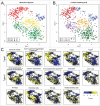Subgroup-specific immune and stromal microenvironment in medulloblastoma
- PMID: 30228931
- PMCID: PMC6140816
- DOI: 10.1080/2162402X.2018.1462430
Subgroup-specific immune and stromal microenvironment in medulloblastoma
Abstract
Knowledge on immune and stromal cells in medulloblastoma microenvironment is still limited as previous work was frequently restricted by low sample size and the lack of molecular subgroup information. We characterized 10 microenvironment cell populations as well as PD-L1 from gene expression in 1422 brain tumors and 763 medulloblastomas. All in all, medulloblastomas showed low expression of immune markers. Still, there were substantial differences with a clustering of medulloblastoma subgroups according to their microenvironment profile. Specifically, SHH medulloblastomas displayed strong signatures of fibroblasts, T cells and macrophages, while markers of cytotoxic lymphocytes were enriched in Group 4 tumors. PD-L1 gene expression appeared to be relatively high in single SHH and WNT cases but was undetectable by immunohistochemistry. In addition, two diverse immuno-stromal patterns were identified, indicating distinct types of local tumor immunosuppression, which were primarily controlled by either macrophage and regulatory T cell-mediated mechanisms or immunosuppressive cytokines and checkpoints, respectively. None of the immune cell signatures had an independent prognostic value in the present dataset after multiple testing correction. These results suggest a mild, but subgroup-specific infiltration of immune cells in medulloblastoma.
Keywords: PD-L1, stroma; gene expression; immune system; medulloblastoma; microenvironment.
Figures




References
Publication types
LinkOut - more resources
Full Text Sources
Other Literature Sources
Research Materials
